Liquidity is one of the most crucial aspects of financial markets, influencing everything from price stability to trade execution. In simple terms, liquidity refers to how quickly and easily an asset can be bought or sold without significantly affecting its price. Markets with high liquidity allow traders to enter and exit positions smoothly, ensuring fair pricing and minimal transaction delays. On the other hand, illiquid markets can result in wider bid-ask spreads, higher trading costs, and price slippage, making it harder for investors to execute trades efficiently. Understanding liquidity is essential for traders, investors, and businesses alike, as it impacts risk management, market efficiency, and overall financial stability. This article explores the concept of liquidity, its different types, how it is measured, and why it plays a fundamental role in ensuring seamless trading in financial markets.
What is Liquidity in Financial Markets?
Liquidity in financial markets refers to the ease with which assets can be bought or sold without causing significant changes in their price. It determines how efficiently transactions can occur and plays a critical role in market stability. The most liquid asset is cash since it can be used immediately for transactions without any loss in value. Other assets, such as stocks, bonds, and commodities, vary in liquidity based on trading volume, market demand, and the presence of buyers and sellers. For instance, stocks of large companies traded on major exchanges tend to be highly liquid, whereas real estate or rare collectibles may take longer to sell, making them illiquid. High liquidity ensures tighter bid-ask spreads, faster trade execution, and lower transaction costs, creating a more efficient and accessible market for investors and traders.
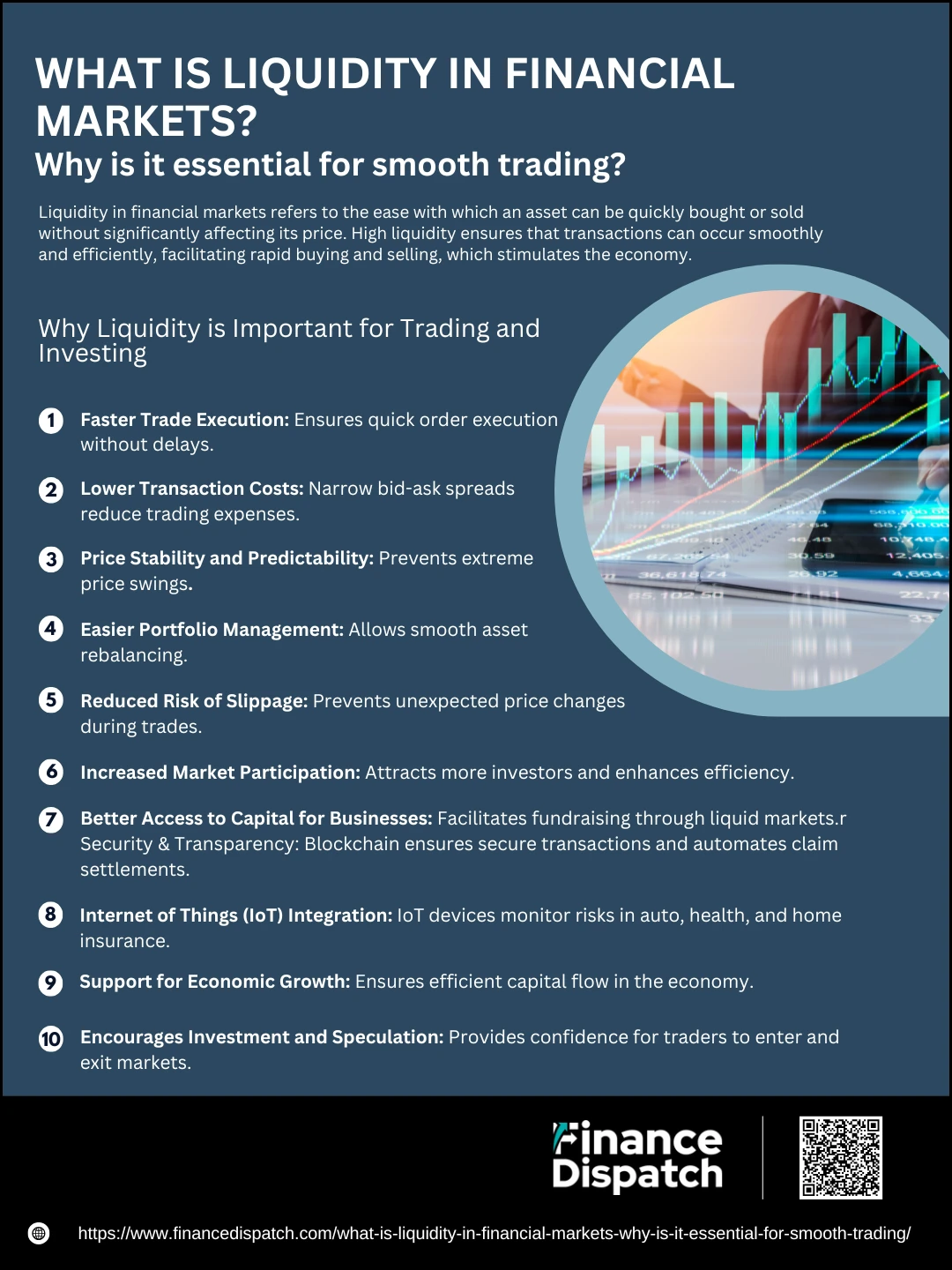 Why Liquidity is Important for Trading and Investing
Why Liquidity is Important for Trading and Investing
Liquidity is one of the most crucial factors in financial markets, directly affecting the ease and efficiency of trading. It determines how quickly assets can be bought or sold without causing drastic price fluctuations. In highly liquid markets, there are plenty of buyers and sellers, ensuring that trades can be executed smoothly at stable prices. However, in illiquid markets, transactions can be delayed, bid-ask spreads widen, and traders may have to accept unfavorable prices to complete a trade. This makes liquidity an essential consideration for both short-term traders and long-term investors, as it impacts transaction costs, market stability, and overall investment strategy.
Key Reasons Why Liquidity Matters in Trading and Investing
1. Faster Trade Execution
High liquidity ensures that buy and sell orders are executed almost instantly. Traders don’t have to wait for a counterparty, allowing them to react quickly to market opportunities and risks.
2. Lower Transaction Costs
When a market is liquid, the difference between the bid price (what buyers are willing to pay) and the ask price (what sellers want) is smaller. This reduces trading costs and ensures that investors get better value for their trades.
3. Price Stability and Predictability
Liquid markets prevent extreme price swings. Since there are enough buyers and sellers, assets trade at their fair market value, making pricing more stable and predictable for investors.
4. Easier Portfolio Management
Investors and fund managers can easily buy or sell assets to rebalance their portfolios without causing significant price disruptions. This flexibility is key to effective risk management and long-term wealth building.
5. Reduced Risk of Slippage
In illiquid markets, placing a large order can cause prices to shift before the trade is completed, leading to losses. High liquidity ensures that assets are traded at prices closer to what the investor expects.
6. Increased Market Participation
Liquid markets attract more investors, including institutional players, which further improves efficiency. This creates a positive cycle of liquidity, making markets more accessible to all types of traders.
7. Better Access to Capital for Businesses
Companies benefit from liquid financial markets by raising capital through stock and bond issuance. When investors know they can easily trade securities, they are more willing to invest, helping businesses grow.
8. Financial Security During Economic Crises
In times of market downturns or economic uncertainty, liquid assets can be sold quickly to access cash. This is particularly important for investors who need to manage risks and secure funds in emergencies.
9. Support for Economic Growth
A liquid financial market allows money to flow efficiently between investors, businesses, and governments. This supports economic development by ensuring that capital is available where it’s needed most.
10. Encourages Investment and Speculation
High liquidity enables traders to take positions confidently, knowing they can exit the market whenever necessary. This drives innovation and competition in the financial sector.
Types of Liquidity
Liquidity is essential in financial markets, as it affects how quickly and easily assets can be converted into cash without significant price changes. It impacts trade execution, investment strategies, and financial stability. Different types of liquidity exist, each playing a distinct role in ensuring that markets, businesses, and individuals can efficiently manage their financial resources. Understanding these types helps investors make informed decisions and businesses maintain financial stability.
Main Types of Liquidity
1. Market Liquidity
This refers to how easily assets can be bought and sold in a market without causing major price fluctuations. Highly liquid markets, such as major stock exchanges, have many buyers and sellers, making it easy to trade assets like large-cap stocks and government bonds. In contrast, markets for rare collectibles or real estate tend to be less liquid, as it takes longer to find buyers.
2. Accounting Liquidity
This measures a company’s or individual’s ability to pay off short-term obligations using available liquid assets. It is commonly assessed using financial ratios such as:
- Current Ratio – Compares current assets to current liabilities to determine financial health.
- Quick Ratio (Acid-Test Ratio) – Excludes inventory to focus on the most liquid assets.
- Cash Ratio – Considers only cash and cash equivalents to evaluate immediate solvency.
3. Asset Liquidity
The ease with which a specific asset can be converted into cash without losing value. Cash is the most liquid asset, as it can be used immediately for transactions. Other financial instruments, like publicly traded stocks, have high liquidity because they can be sold quickly. On the other hand, assets such as real estate, artwork, and private equity investments are illiquid because they take longer to sell and may require discounts to attract buyers.
4. Funding Liquidity
This applies to banks, financial institutions, and businesses, indicating their ability to access cash or credit to meet financial obligations. Institutions with strong funding liquidity can efficiently manage cash flows, issue loans, and handle withdrawals. A liquidity crisis occurs when banks or businesses cannot secure the necessary funds to continue operations, leading to financial instability.
5. Monetary Liquidity
This refers to the overall availability of money and credit in an economy. Central banks, such as the Federal Reserve, influence monetary liquidity through interest rate policies and money supply regulation. Higher liquidity in the economy encourages lending and investment, while lower liquidity can slow economic growth to control inflation.
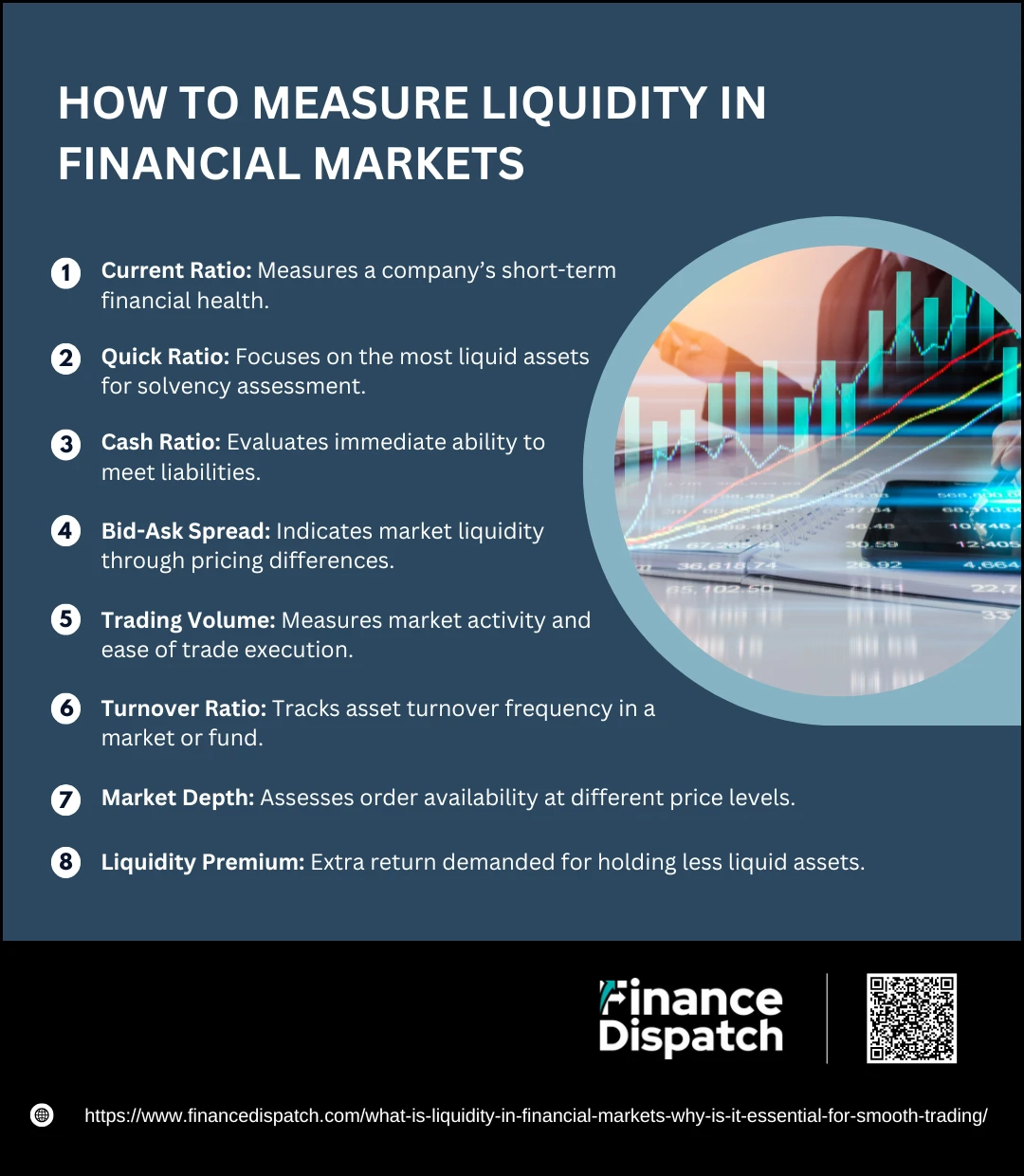 How to Measure Liquidity in Financial Markets
How to Measure Liquidity in Financial Markets
Liquidity is a key indicator of how efficiently financial markets function, determining how quickly assets can be bought or sold without significantly affecting their price. Investors and analysts use various financial metrics to assess liquidity, helping them understand market stability, trading efficiency, and financial health. Measuring liquidity allows traders to manage risks effectively, while businesses can use liquidity assessments to ensure they have enough resources to meet short-term obligations.
Key Methods to Measure Liquidity in Financial Markets
1. Current Ratio
This ratio compares a company’s current assets to its current liabilities. A ratio above 1 indicates that a company has more liquid assets than short-term debts, suggesting good liquidity.
Formula:
Current Ratio = Current Assets ÷ Current Liabilities
2. Quick Ratio (Acid-Test Ratio)
A stricter measure than the current ratio, this ratio excludes inventory and focuses on cash, short-term investments, and accounts receivable, which are easier to convert into cash.
Formula:
Quick Ratio = (Cash + Short-Term Investments + Accounts Receivable) ÷ Current Liabilities
3. Cash Ratio
The most conservative liquidity measure, the cash ratio only considers cash and cash equivalents, showing a firm’s ability to meet short-term liabilities with its most liquid assets.
Formula:
Cash Ratio = Cash and Cash Equivalents ÷ Current Liabilities
4. Bid-Ask Spread
A market-based measure of liquidity, the bid-ask spread represents the difference between the highest price a buyer is willing to pay (bid) and the lowest price a seller is willing to accept (ask). Narrow spreads indicate high liquidity, while wider spreads suggest lower liquidity and higher trading costs.
5. Trading Volume
This metric shows the number of shares, contracts, or units of an asset traded within a specific period. Higher trading volumes indicate greater market liquidity, as it is easier to buy or sell large quantities without moving the price significantly.
6. Turnover Ratio
This measures the frequency at which assets are bought and sold within a market or investment fund. A higher turnover ratio indicates more liquidity, while a lower ratio suggests limited trading activity.
7. Market Depth
This metric evaluates the number of buy and sell orders at different price levels. A market with high depth can absorb large transactions without causing substantial price changes, making it highly liquid.
8. Liquidity Premium
This is the extra return investors demand for holding an illiquid asset. A higher liquidity premium suggests lower market liquidity, as investors require compensation for the difficulty of selling the asset quickly.
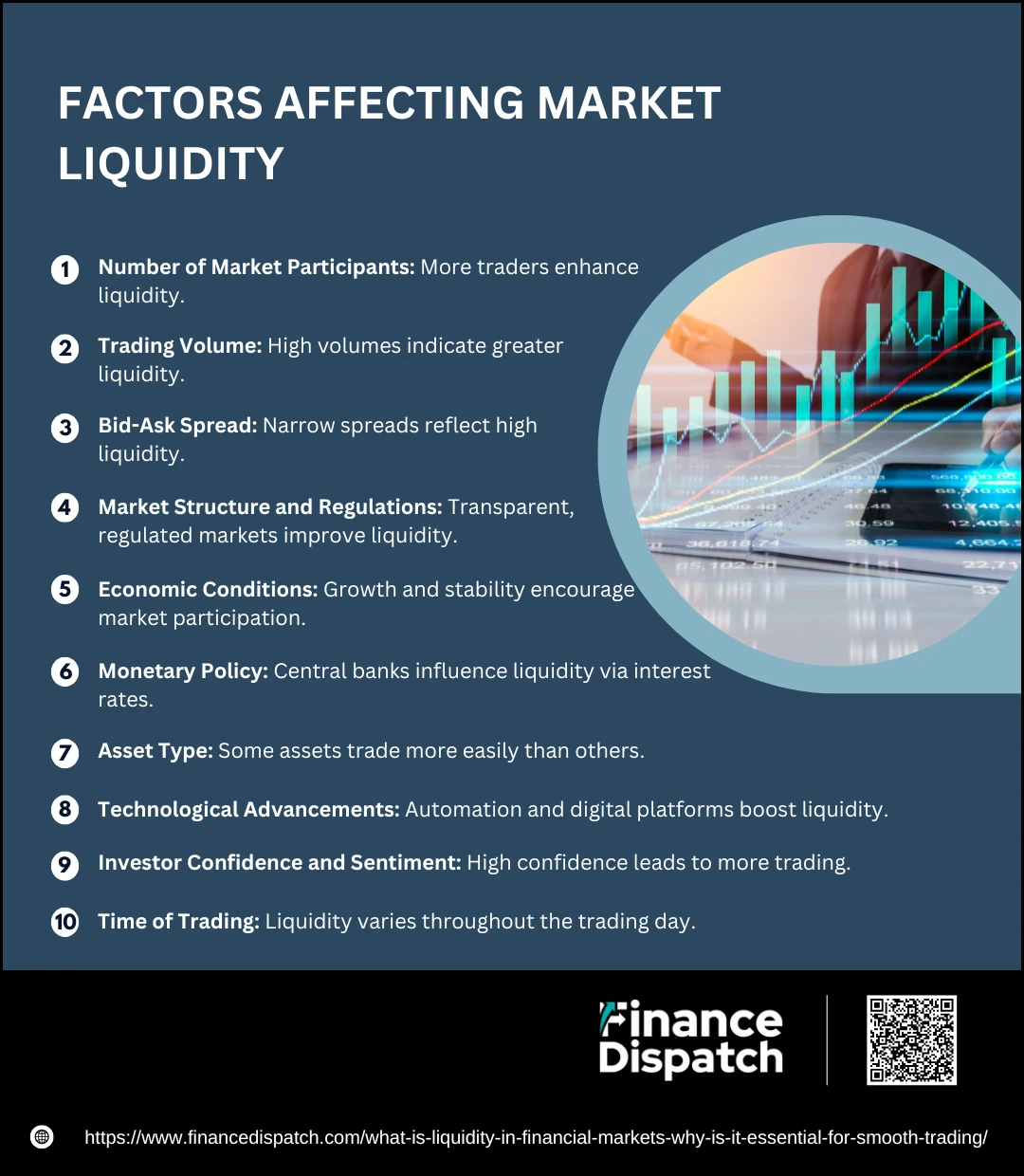 Factors Affecting Market Liquidity
Factors Affecting Market Liquidity
Market liquidity plays a crucial role in ensuring that financial assets can be traded efficiently without causing large price swings. Highly liquid markets provide stability, allowing traders and investors to buy and sell assets with minimal friction. In contrast, illiquid markets can experience sharp price movements, higher transaction costs, and difficulty in executing trades. Liquidity is influenced by various factors, including economic conditions, market structure, and investor behavior. Understanding these factors helps traders, investors, and policymakers anticipate liquidity risks and make informed financial decisions.
Key Factors That Influence Market Liquidity
1. Number of Market Participants
The more buyers and sellers present in a market, the easier it is to trade assets without significantly impacting their prices. A diverse mix of retail investors, institutional investors, and market makers enhances liquidity.
2. Trading Volume
Markets with high trading activity, such as major stock exchanges and forex markets, have greater liquidity. A higher volume of transactions ensures that assets can be bought or sold quickly at stable prices.
3. Bid-Ask Spread
The difference between the highest price a buyer is willing to pay (bid) and the lowest price a seller is willing to accept (ask) is an indicator of liquidity. A narrow bid-ask spread signifies a highly liquid market, while a wider spread suggests lower liquidity and higher trading costs.
4. Market Structure and Regulations
Well-organized markets with clear regulations, transparency, and active oversight promote liquidity. Regulated exchanges such as the NYSE and NASDAQ offer higher liquidity than over-the-counter (OTC) markets, where trading can be less structured.
5. Economic Conditions
A strong economy with stable growth, low inflation, and favorable business conditions fosters liquidity. Conversely, economic downturns, financial crises, or geopolitical instability can reduce market activity, causing liquidity to dry up.
6. Monetary Policy
Central banks play a vital role in influencing liquidity through interest rate adjustments and money supply management. Lower interest rates and increased money supply boost liquidity by encouraging borrowing and investment, while tighter monetary policies can reduce liquidity.
7. Asset Type
Different assets have varying levels of liquidity. Large-cap stocks and government bonds are more liquid due to active trading and strong demand. In contrast, assets like real estate, private equity, and rare collectibles are less liquid and may take longer to sell.
8. Technological Advancements
The rise of electronic trading platforms, high-frequency trading (HFT), and algorithmic trading has significantly improved market liquidity by enabling faster trade execution and greater market participation.
9. Investor Confidence and Sentiment
Market liquidity is also influenced by investor perception. When confidence is high, investors actively participate in trading, boosting liquidity. However, uncertainty, panic, or negative news can lead to reduced market activity and liquidity crunches.
10. Time of Trading
Liquidity fluctuates throughout the trading day. During peak hours, when major financial markets are open, liquidity is high. However, in after-hours or pre-market trading sessions, liquidity tends to be lower due to reduced market participation.
Examples of Liquid and Illiquid Assets
Liquidity refers to how easily an asset can be converted into cash without significantly impacting its price. Highly liquid assets can be sold quickly at market value, while illiquid assets may take longer to sell and may require a price discount. Investors and businesses must understand asset liquidity to make informed financial decisions, ensuring they have access to cash when needed. Below is a comparison of liquid and illiquid assets across different asset classes.
Comparison of Liquid and Illiquid Assets
| Asset Type | Liquidity Level | Examples |
| Highly Liquid | Very High | Cash, money market accounts, treasury bills, major currency pairs (USD, EUR) |
| Moderately Liquid | Medium | Blue-chip stocks, ETFs, corporate bonds, mutual funds, precious metals (gold, silver) |
| Limited Liquidity | Low | Small-cap stocks, high-yield bonds, collectibles (rare coins, vintage cars) |
| Illiquid | Very Low | Real estate, private equity, artwork, intellectual property, business ownership |
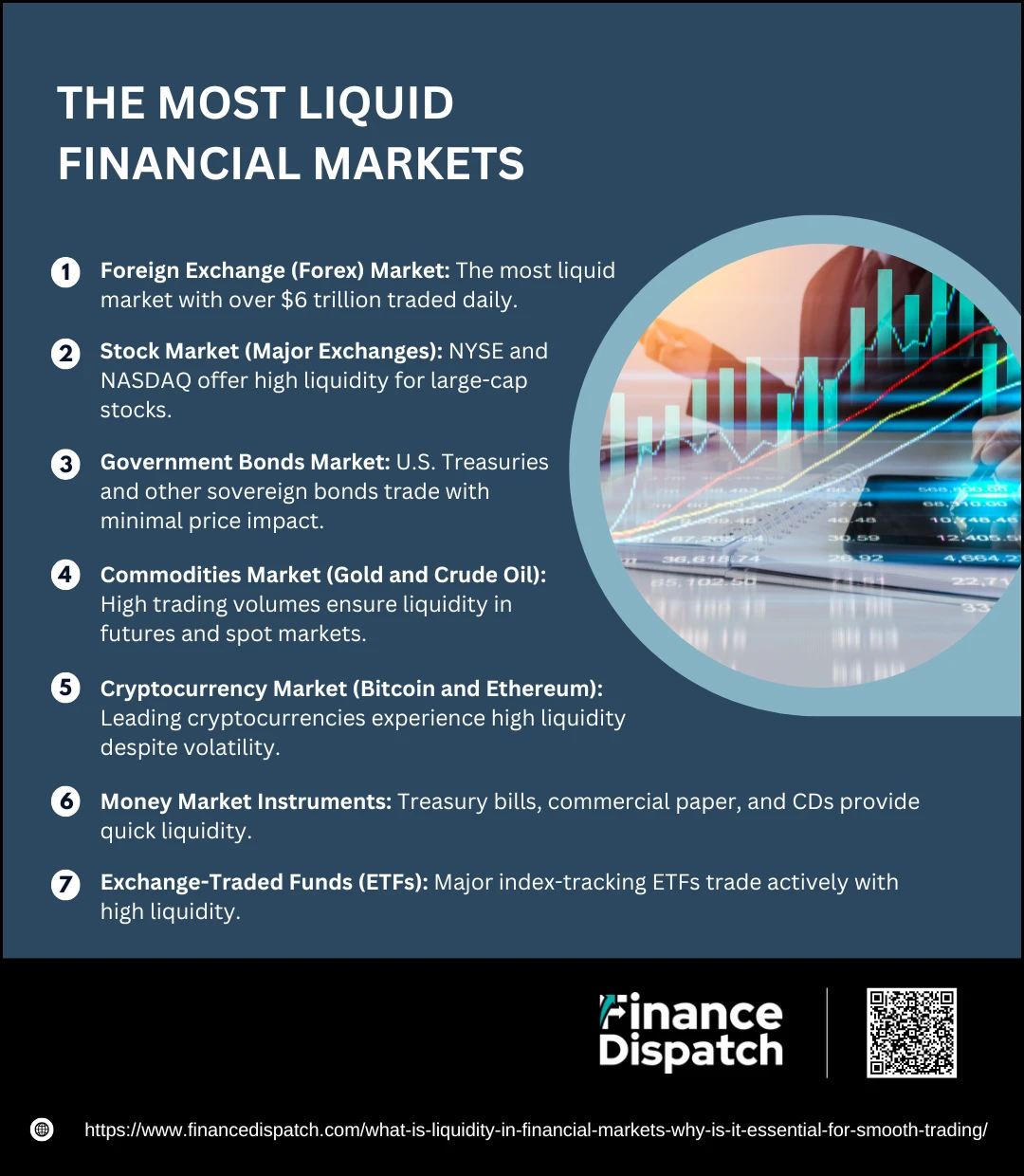 The Most Liquid Financial Markets
The Most Liquid Financial Markets
Liquidity is a key characteristic of an efficient financial market, allowing traders and investors to buy and sell assets quickly without significantly affecting prices. Highly liquid markets have a large number of participants, high trading volumes, and narrow bid-ask spreads, making transactions smooth and cost-effective. These markets are essential for global trade, investment, and economic stability. Below are some of the most liquid financial markets in the world.
Top Liquid Financial Markets
1. Foreign Exchange (Forex) Market
The forex market is the most liquid financial market globally, with over $6 trillion traded daily. Major currency pairs like EUR/USD, GBP/USD, and USD/JPY experience continuous trading, ensuring high liquidity and minimal price fluctuations.
2. Stock Market (Major Exchanges)
Large stock exchanges like the New York Stock Exchange (NYSE) and NASDAQ have high trading volumes, making stocks of large-cap companies (e.g., Apple, Microsoft, Amazon) highly liquid. These stocks are actively traded with small bid-ask spreads.
3. Government Bonds Market
U.S. Treasury bonds, German Bunds, and Japanese Government Bonds (JGBs) are highly liquid due to strong demand from institutional investors and central banks. These bonds can be traded quickly without major price changes.
4. Commodities Market (Gold and Crude Oil)
Gold and crude oil are among the most traded commodities, with high liquidity in futures and spot markets. Gold, in particular, is a safe-haven asset, ensuring steady trading volume.
5. Cryptocurrency Market (Bitcoin and Ethereum)
While the cryptocurrency market is volatile, major cryptocurrencies like Bitcoin (BTC) and Ethereum (ETH) have high liquidity due to widespread adoption and trading on global exchanges.
6. Money Market Instruments
Short-term instruments like Treasury bills (T-bills), commercial paper, and certificates of deposit (CDs) are highly liquid, as they mature quickly and can be sold with minimal impact on price.
7. Exchange-Traded Funds (ETFs)
ETFs that track major indices (e.g., S&P 500 ETFs) are highly liquid, as they are actively traded and provide investors with instant diversification.
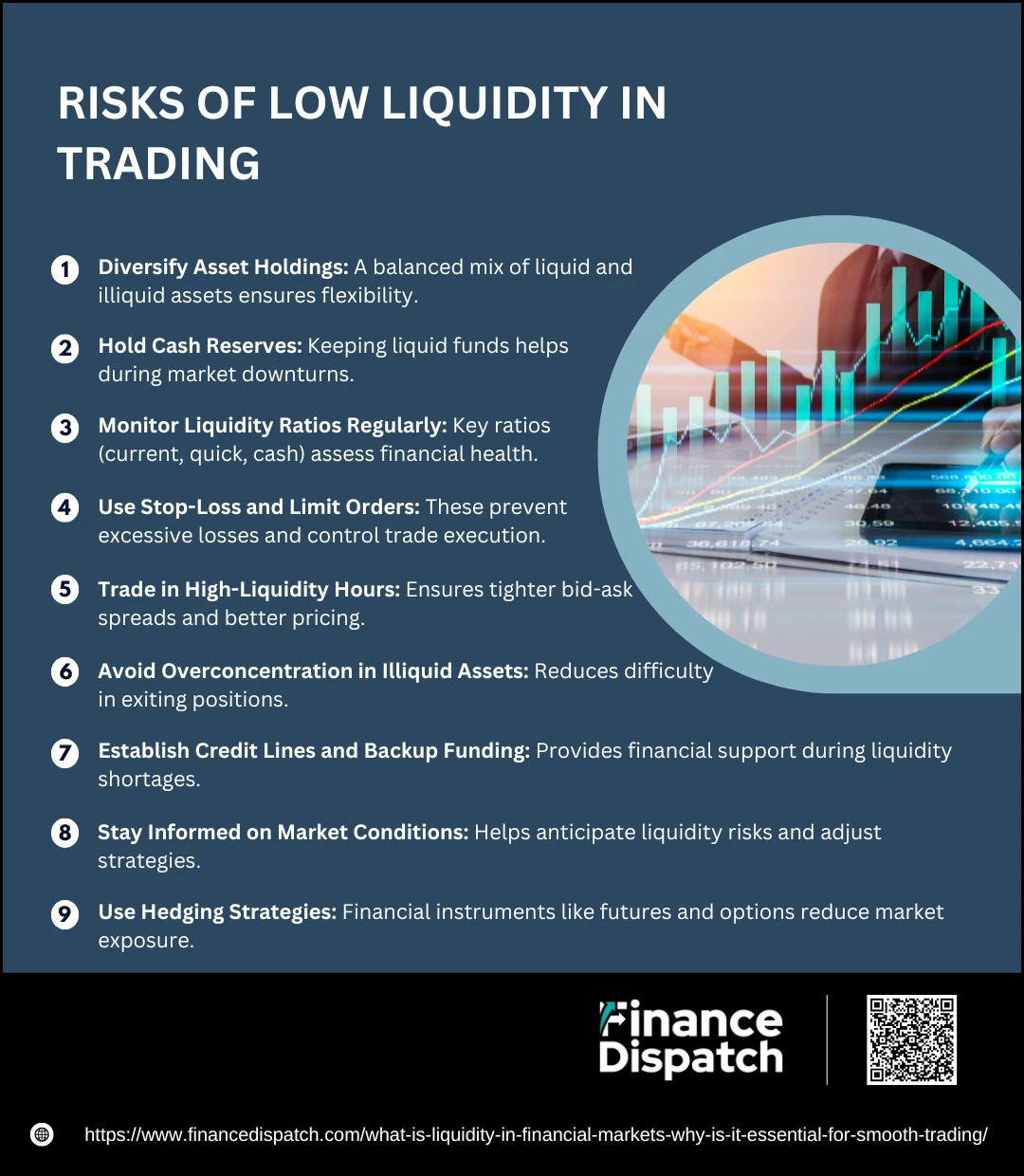 Risks of Low Liquidity in Trading
Risks of Low Liquidity in Trading
Low liquidity in trading can pose significant risks for investors and market participants, leading to increased volatility, higher transaction costs, and difficulty in executing trades at desired prices. In illiquid markets, assets may take longer to sell, and large trades can cause substantial price swings, resulting in unfavorable execution for traders. A wider bid-ask spread is another consequence, forcing buyers to pay more and sellers to accept less than the asset’s fair value. Additionally, low liquidity increases the risk of slippage, where an order is executed at a price different from what was initially expected due to a lack of available counterparties. During market downturns or economic crises, illiquid assets can become even harder to sell, leading to forced sales at steep discounts. Investors holding illiquid securities may also struggle to adjust their portfolios quickly in response to market changes, increasing their exposure to potential losses. Therefore, understanding and managing liquidity risks is crucial for traders and investors to ensure smooth trade execution and minimize financial losses.
Strategies to Manage Liquidity Risk
Liquidity risk occurs when an investor, trader, or business struggles to buy or sell assets quickly without significantly impacting their price. This risk can lead to financial distress, forced asset sales at a discount, or the inability to meet short-term obligations. Markets with low liquidity often experience wider bid-ask spreads, higher volatility, and price slippage, making it crucial for participants to adopt effective liquidity management strategies. Whether you are an individual investor, a business, or an institutional trader, managing liquidity risk ensures financial stability, minimizes transaction costs, and improves market efficiency. Below are key strategies to mitigate liquidity risk in financial markets.
Effective Strategies to Manage Liquidity Risk
1. Diversify Asset Holdings
A well-balanced portfolio with a mix of liquid and illiquid assets helps ensure financial flexibility. Holding a variety of assets, such as stocks, bonds, and real estate, reduces reliance on any single market for liquidity.
2. Hold Cash Reserves
Maintaining a portion of assets in cash or highly liquid instruments (e.g., Treasury bills, money market funds) provides an immediate source of funds during financial crises or market downturns.
3. Monitor Liquidity Ratios Regularly
Investors and businesses should track key liquidity ratios, such as:
- Current Ratio – Measures a company’s ability to cover short-term liabilities.
- Quick Ratio (Acid-Test Ratio) – Assesses liquidity by excluding inventory from assets.
- Cash Ratio – Evaluates an entity’s ability to meet obligations using only cash and cash equivalents.
4. Use Stop-Loss and Limit Orders
Setting stop-loss orders protects against sudden market drops by automatically selling assets at a predetermined price. Limit orders help investors execute trades at favorable prices without excessive price slippage.
5. Trade in High-Liquidity Hours
Liquidity fluctuates throughout the day. Trading during peak hours—when major financial markets are open—ensures tighter bid-ask spreads and reduces execution risks.
6. Avoid Overconcentration in Illiquid Assets
Investing heavily in low-volume assets (e.g., private equity, small-cap stocks, exotic bonds) can make it difficult to exit positions quickly. Maintaining a liquidity buffer within a portfolio prevents unnecessary financial stress.
7. Establish Credit Lines and Backup Funding
Businesses and institutional investors should secure lines of credit or maintain access to alternative funding sources to cover unexpected liquidity shortages.
8. Stay Informed on Market Conditions
Liquidity levels shift based on economic trends, monetary policies, and investor sentiment. Understanding these factors allows investors to anticipate liquidity risks and adjust their strategies accordingly.
9. Use Hedging Strategies
Financial instruments like futures, options, and swaps can help manage liquidity risk by reducing exposure to market fluctuations and providing alternative ways to exit positions.
Conclusion
Managing liquidity effectively is essential for both individual investors and businesses to ensure financial stability and smooth trading operations. Liquidity risk can lead to significant challenges, including price slippage, higher transaction costs, and difficulty in executing trades at desired prices. By implementing strategies such as diversifying asset holdings, maintaining cash reserves, using stop-loss and limit orders, and monitoring liquidity ratios, market participants can mitigate these risks and navigate financial markets more efficiently. Understanding the factors that influence liquidity and staying informed about market conditions also play a crucial role in making sound investment decisions. Ultimately, a well-planned liquidity management strategy not only enhances financial flexibility but also protects against unforeseen market disruptions, ensuring long-term financial health and stability.



